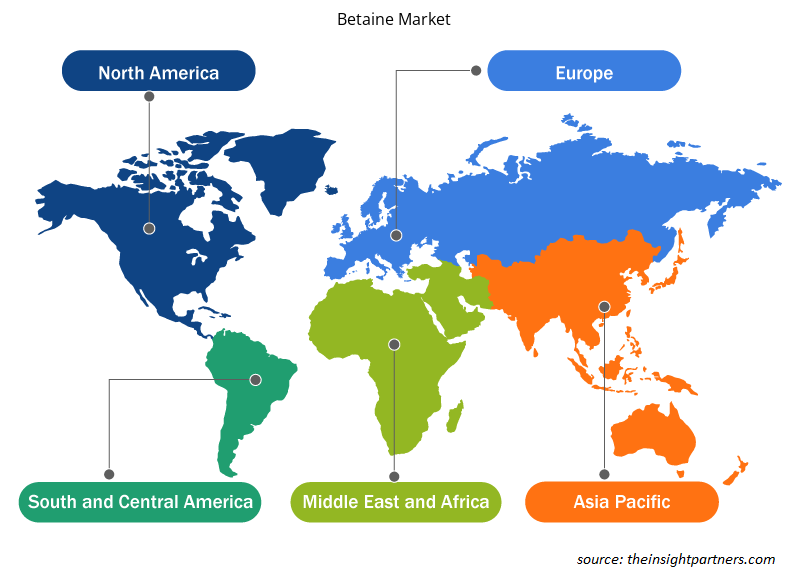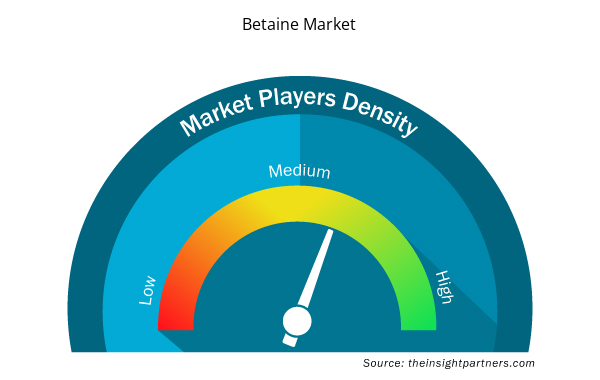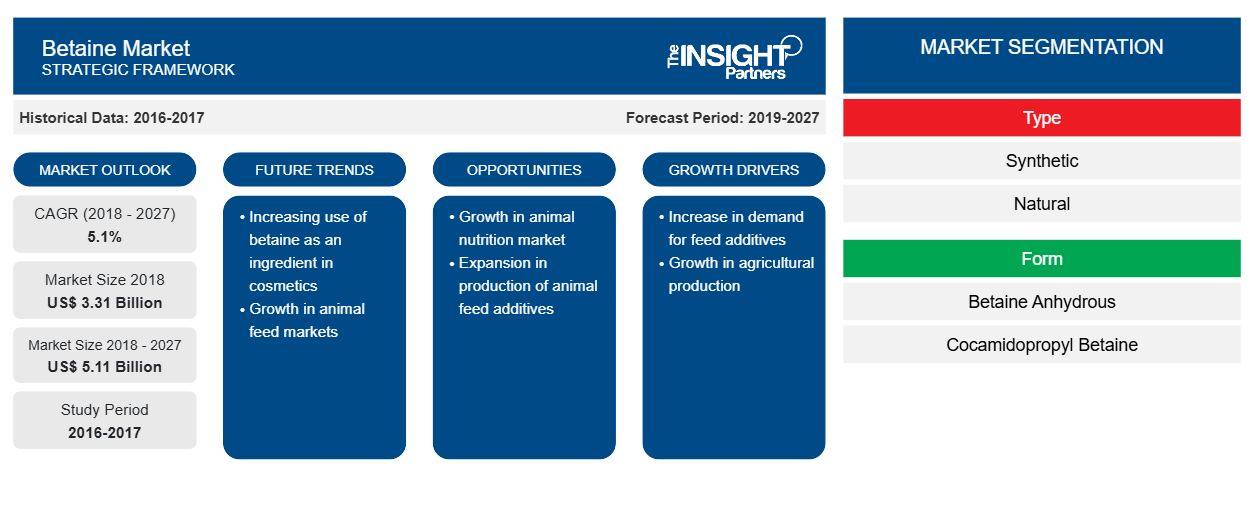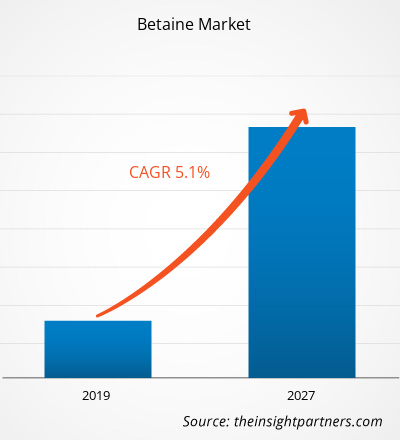[研究报告] 2018 年甜菜碱市场价值为 33.12 亿美元,预计在 2019-2027 年预测期内复合年增长率为 5.1%,到 2027 年将达到 51.1 亿美元。
甜菜碱也被称为甘氨酸甜菜碱或无水甜菜碱。它是一种可以自然或合成获得的化合物。它通常是从甜菜根生产糖的炼油厂获得的副产品。甜菜碱的其他一些天然资源包括麦麸、菠菜、苋菜籽、红薯、藜麦、黑麦、碾碎干小麦、火鸡胸肉、牛肉和小牛肉。甜菜碱用于各种应用,包括食品和饮料、药品和保健食品、动物饲料和化妆品。人们越来越意识到甜菜碱在膳食补充剂中的营养价值,以及其多功能用途,如表面活性剂和甲基供体,是推动其在市场需求的主要因素之一。
预计在预测期内,亚太地区研究市场将以 5.9% 的最高复合年增长率增长。亚太地区研究市场的增长主要归因于用于生产甜菜碱的原材料的广泛和易得性。预计在预测期内,亚太地区消费者对营养产品以及膳食补充剂的需求不断增加将推动市场发展。食用含甜菜碱产品带来的多种健康益处,如提高肌肉力量、新陈代谢和耐力,预计将在不久的将来进一步刺激产品需求。甜菜碱还用于饲料添加剂中以增强动物的新陈代谢。预计在预测期内,主要在饲料中营养缺陷的增加将增加对营养价值饲料添加剂的需求。这将进一步支持该地区研究市场的增长。廉价劳动力,包括印度和中国等国家原材料的易得性,也有望促进该地区这些产品的生产。
定制此报告以满足您的需求
您可以免费定制任何报告,包括本报告的部分内容、国家级分析、Excel 数据包,以及为初创企业和大学提供优惠和折扣
- 获取此报告的关键市场趋势。这个免费样品将包括数据分析,从市场趋势到估计和预测。
市场洞察
多种终端应用需求不断增长
食品和饮料、个人护理和化妆品、保健食品和药品等多个终端行业对天然成分的需求日益增加。这些行业在其产品中广泛使用甜菜碱。对使用甜菜碱的能量和运动饮料的需求增加进一步扩大了全球甜菜碱市场的范围。食用这些产品有助于进一步提高身体机能,特别是肌肉力量,并增强免疫系统。甜菜碱还因其保湿和保水特性而被用作个人护理和化妆品中的表面活性剂。它也适用于洗涤剂和试剂。作为动物饲料添加剂,甜菜碱有助于增强动物的新陈代谢。由于甜菜碱具有健康益处,其在补充剂中的广泛使用以及在各个行业的应用不断增加,进一步推动了对甜菜碱的需求。甜菜碱在保健食品和制药行业的应用日益增多,对全球甜菜碱市场的增长产生了积极影响。
类型洞察
根据类型,甜菜碱市场分为合成甜菜碱和天然甜菜碱。2018 年,合成甜菜碱占据了最大的市场份额,而天然甜菜碱市场预计在预测期内将以最高的复合年增长率增长。合成甜菜碱的需求激增,由于其保水性和保湿性,可用于个人护理产品。由于其保水能力,甜菜碱还被用作表面活性剂,主要用于化妆品行业。如今,甜菜碱以甜菜碱盐酸盐形式广泛用于多种应用的合成产品中。甜菜碱无水物提取的主要来源是甜菜。甜菜碱也是肉鸡养殖中重要的营养成分。
表单洞察
根据形式,甜菜碱市场分为无水甜菜碱、椰油酰胺丙基甜菜碱和其他。椰油酰胺丙基甜菜碱部分在 2018 年占据了最大的市场份额。椰油酰胺丙基甜菜碱是一种合成表面活性剂,主要来源于椰子油和二甲氨基丙胺。它基本上是一种粘稠的淡黄色透明液体,用作洗发水和洗手液、剃须膏、卸妆液、沐浴露等产品的表面活性剂,甚至在化妆品中用作增稠剂和乳化剂,用于减少这些产品的刺激。这种物质主要用于发泡产品中产生丰富、浓密的泡沫。它进一步软化头发,减少护发素中的静电。它还可以作为护发素中的抗静电剂。椰油酰胺丙基甜菜碱可以是生物基的,也可以是合成的,但两者都被认为可以安全地用于化妆品中。
并购和研发是企业扩大全球业务范围的常用策略,这进一步影响了市场规模。甜菜碱市场的参与者(如 Ridley Corporation Limited)一直在实施上述策略,以扩大客户群并在全球市场中获得显著份额,这也使他们能够在全球范围内保持自己的品牌名称。
报告亮点
- 全球甜菜碱市场的渐进式行业趋势,帮助参与者制定有效的长期战略
- 发达市场和发展中市场公司采用的业务增长战略
- 2017 年至 2027 年全球甜菜碱市场定量分析
- 全球各行业对甜菜碱需求量的估计
- PEST 分析阐明了在甜菜碱生态系统中运营的买家和供应商的效力
- 了解竞争激烈的市场形势和全球甜菜碱需求的最新发展
- 市场趋势和前景,以及推动和抑制全球甜菜碱市场增长的因素
- 通过了解支撑全球甜菜碱市场增长商业利益的战略,帮助制定决策
- 全球甜菜碱市场各节点规模
- 全球甜菜碱市场的详细概述和细分,以及甜菜碱行业动态
- 全球甜菜碱市场各地区规模及增长机遇
甜菜碱市场区域洞察
Insight Partners 的分析师已详细解释了预测期内影响甜菜碱市场的区域趋势和因素。本节还讨论了北美、欧洲、亚太地区、中东和非洲以及南美和中美洲的甜菜碱市场细分和地理位置。

- 获取甜菜碱市场的区域特定数据
甜菜碱市场报告范围
| 报告属性 | 细节 |
|---|---|
| 2018 年市场规模 | 33.1亿美元 |
| 2027 年市场规模 | 51.1亿美元 |
| 全球复合年增长率(2018 - 2027) | 5.1% |
| 史料 | 2016-2017 |
| 预测期 | 2019-2027 |
| 涵盖的领域 | 按类型
|
| 覆盖地区和国家 | 北美
|
| 市场领导者和主要公司简介 |
|
甜菜碱市场参与者密度:了解其对业务动态的影响
甜菜碱市场正在快速增长,这得益于终端用户需求的不断增长,而这些需求又源于消费者偏好的不断变化、技术进步以及对产品优势的认识不断提高等因素。随着需求的增加,企业正在扩大其产品范围,进行创新以满足消费者的需求,并利用新兴趋势,从而进一步推动市场增长。
市场参与者密度是指在特定市场或行业内运营的企业或公司的分布情况。它表明在给定市场空间中,相对于其规模或总市场价值,有多少竞争对手(市场参与者)存在。
在甜菜碱市场运营的主要公司有:
- 美国水晶糖公司
- 阿米诺有限公司
- 巴斯夫
- 内穆尔桥公司
- 赢创工业集团
免责声明:上面列出的公司没有按照任何特定顺序排列。

- 获取甜菜碱市场顶级关键参与者概览
甜菜碱市场 – 按产品类型
- 自然的
- 合成的
甜菜碱市场 – 按形式
- 无水甜菜碱
- 椰油酰胺丙基甜菜碱
- 其他的
甜菜碱市场 – 按应用
- 食品和饮料
- 动物饲料
- 化妆品
- 清洁剂
- 其他的
公司简介
- 巴斯夫
- 美国水晶糖公司
- AMINO 公司
- EI 杜邦德内穆尔公司
- 赢创工业集团
- 花王株式会社
- 索尔维公司
- Stepan 公司
- 路博润公司
- 潍坊(上海)三沃化工有限公司
- 历史分析(2 年)、基准年、预测(7 年)及复合年增长率
- PEST 和 SWOT 分析
- 市场规模价值/数量 - 全球、区域、国家
- 行业和竞争格局
- Excel 数据集



Report Coverage
Revenue forecast, Company Analysis, Industry landscape, Growth factors, and Trends

Segment Covered
This text is related
to segments covered.

Regional Scope
North America, Europe, Asia Pacific, Middle East & Africa, South & Central America

Country Scope
This text is related
to country scope.
Trends and growth analysis reports related to Food and Beverages : READ MORE..
The List of Companies
- AMERICAN CRYSTAL SUGAR COMPANY
- AMINO GMBH
- BASF SE
- E. I. DU PONT DE NEMOURS AND COMPANY
- EVONIK INDUSTRIES AG
- KAO CORPORATION
- THE LUBRIZOL CORPORATION
- SOLVAY
- STEPAN COMPANY
- WEIFANG (SHANGHAI) SUNWIN CHEMICALS CO LTD
The Insight Partners performs research in 4 major stages: Data Collection & Secondary Research, Primary Research, Data Analysis and Data Triangulation & Final Review.
- Data Collection and Secondary Research:
As a market research and consulting firm operating from a decade, we have published and advised several client across the globe. First step for any study will start with an assessment of currently available data and insights from existing reports. Further, historical and current market information is collected from Investor Presentations, Annual Reports, SEC Filings, etc., and other information related to company’s performance and market positioning are gathered from Paid Databases (Factiva, Hoovers, and Reuters) and various other publications available in public domain.
Several associations trade associates, technical forums, institutes, societies and organization are accessed to gain technical as well as market related insights through their publications such as research papers, blogs and press releases related to the studies are referred to get cues about the market. Further, white papers, journals, magazines, and other news articles published in last 3 years are scrutinized and analyzed to understand the current market trends.
- Primary Research:
The primarily interview analysis comprise of data obtained from industry participants interview and answers to survey questions gathered by in-house primary team.
For primary research, interviews are conducted with industry experts/CEOs/Marketing Managers/VPs/Subject Matter Experts from both demand and supply side to get a 360-degree view of the market. The primary team conducts several interviews based on the complexity of the markets to understand the various market trends and dynamics which makes research more credible and precise.
A typical research interview fulfils the following functions:
- Provides first-hand information on the market size, market trends, growth trends, competitive landscape, and outlook
- Validates and strengthens in-house secondary research findings
- Develops the analysis team’s expertise and market understanding
Primary research involves email interactions and telephone interviews for each market, category, segment, and sub-segment across geographies. The participants who typically take part in such a process include, but are not limited to:
- Industry participants: VPs, business development managers, market intelligence managers and national sales managers
- Outside experts: Valuation experts, research analysts and key opinion leaders specializing in the electronics and semiconductor industry.
Below is the breakup of our primary respondents by company, designation, and region:

Once we receive the confirmation from primary research sources or primary respondents, we finalize the base year market estimation and forecast the data as per the macroeconomic and microeconomic factors assessed during data collection.
- Data Analysis:
Once data is validated through both secondary as well as primary respondents, we finalize the market estimations by hypothesis formulation and factor analysis at regional and country level.
- Macro-Economic Factor Analysis:
We analyse macroeconomic indicators such the gross domestic product (GDP), increase in the demand for goods and services across industries, technological advancement, regional economic growth, governmental policies, the influence of COVID-19, PEST analysis, and other aspects. This analysis aids in setting benchmarks for various nations/regions and approximating market splits. Additionally, the general trend of the aforementioned components aid in determining the market's development possibilities.
- Country Level Data:
Various factors that are especially aligned to the country are taken into account to determine the market size for a certain area and country, including the presence of vendors, such as headquarters and offices, the country's GDP, demand patterns, and industry growth. To comprehend the market dynamics for the nation, a number of growth variables, inhibitors, application areas, and current market trends are researched. The aforementioned elements aid in determining the country's overall market's growth potential.
- Company Profile:
The “Table of Contents” is formulated by listing and analyzing more than 25 - 30 companies operating in the market ecosystem across geographies. However, we profile only 10 companies as a standard practice in our syndicate reports. These 10 companies comprise leading, emerging, and regional players. Nonetheless, our analysis is not restricted to the 10 listed companies, we also analyze other companies present in the market to develop a holistic view and understand the prevailing trends. The “Company Profiles” section in the report covers key facts, business description, products & services, financial information, SWOT analysis, and key developments. The financial information presented is extracted from the annual reports and official documents of the publicly listed companies. Upon collecting the information for the sections of respective companies, we verify them via various primary sources and then compile the data in respective company profiles. The company level information helps us in deriving the base number as well as in forecasting the market size.
- Developing Base Number:
Aggregation of sales statistics (2020-2022) and macro-economic factor, and other secondary and primary research insights are utilized to arrive at base number and related market shares for 2022. The data gaps are identified in this step and relevant market data is analyzed, collected from paid primary interviews or databases. On finalizing the base year market size, forecasts are developed on the basis of macro-economic, industry and market growth factors and company level analysis.
- Data Triangulation and Final Review:
The market findings and base year market size calculations are validated from supply as well as demand side. Demand side validations are based on macro-economic factor analysis and benchmarks for respective regions and countries. In case of supply side validations, revenues of major companies are estimated (in case not available) based on industry benchmark, approximate number of employees, product portfolio, and primary interviews revenues are gathered. Further revenue from target product/service segment is assessed to avoid overshooting of market statistics. In case of heavy deviations between supply and demand side values, all thes steps are repeated to achieve synchronization.
We follow an iterative model, wherein we share our research findings with Subject Matter Experts (SME’s) and Key Opinion Leaders (KOLs) until consensus view of the market is not formulated – this model negates any drastic deviation in the opinions of experts. Only validated and universally acceptable research findings are quoted in our reports.
We have important check points that we use to validate our research findings – which we call – data triangulation, where we validate the information, we generate from secondary sources with primary interviews and then we re-validate with our internal data bases and Subject matter experts. This comprehensive model enables us to deliver high quality, reliable data in shortest possible time.


 获取此报告的免费样本
获取此报告的免费样本